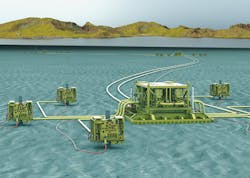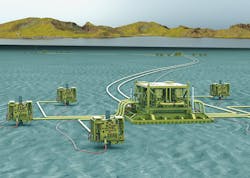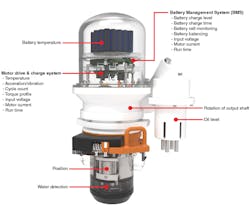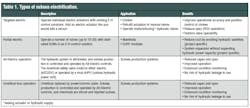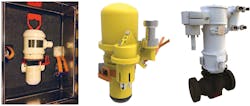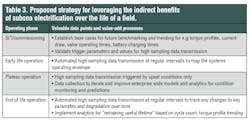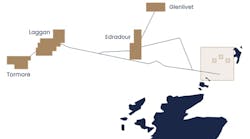Data-driven approach to condition-based maintenance
Kristin Moe Elgsaas, Terje Hjertvikrem, Wei Hua, Svein Tryti, Terje Glomsaker;Baker Hughes, a GE company
Increasing electrification has been and continues to be a trend across multiple industrial markets. This is driven by a combination of factors such as improved reliability of electric systems, better solutions for storing electric energy, cheaper and competitive electric actuators, and solutions processing and using the information available in electric systems. For example, Eidesvik Offshore’sViking Energy became the first supply vessel to use battery technologies in dynamic positioning operations. Looking to aviation, the “More Electric Aircraft” sponsored by companies like Airbus, Boeing, and Lockheed Martin aim to optimize aircraft performance, reduce operating costs, and increase dispatch reliability.
The subsea market is no exception to seeing benefits of electrification, and interest in all-electric subsea solutions has grown significantly these last few years. The trend coincides with subsea electric actuation gaining a solid track record after 15+ years of operational experience, and ongoing industry-wide discussions and validation of the benefits of all-electric systems.
A diverse group of subsea vendors and operators, including BHGE, has shared analyses showing how a move to all-electric subsea production systems reduces cost. Savings are dependent on field layouts and system solutions, but the industry consensus seems to be in the 10-25% range for capex with further significant opex benefits.
In addition to cost savings, there are numerous operational benefits of all-electric subsea systems. These include reduced system complexity, mitigated hydraulic challenges in deepwater and long tiebacks, no risk of hydraulic leaks, and reduced HSE risks related to working on and operating pressurized equipment.
The following will explore the indirect benefits that can be realized from all-electric subsea systems and show how their inherent intelligence could be drivers toward novel ways of thinking about design and operation of subsea production systems.
Subsea electrification
At present, subsea production systems (SPS) are typically controlled and operated through electro-hydraulic means. This means having two parallel energy systems with both power cables and hydraulic lines included in the umbilical coming from the topsides.
Hydraulic power is used to operate all valves and chokes in the system. The hydraulic system typically consists of a topsides hydraulic power unit (HPU) with reservoirs and pump systems, hydraulic lines and associated equipment, subsea accumulators, valves to manage flow and hydraulic actuators. Typically, low pressure is required for SPS valves, and separate high pressure for downhole safety valves where each system tends to have spare hydraulic lines in the umbilical. In summary, supplying hydraulic power to operate the valves and chokes requires a comprehensive system impacting all parts of a subsea field infrastructure.
Electric power is used to run the electronics that control the production system, to power the sensors that monitor it, and to operate the directional control valves (DCV) that manage the path of the pressurized hydraulic liquids used to operate the hydraulic actuators. The DCVs rely on electrical signals from the power system to act, so the two energy systems are not entirely independent. And both systems are required to be functional to maintain field production.
Provided sufficient power were available, the electric system could also be used to operate electric actuators replacing their hydraulic counterparts and in consequence eliminate the hydraulic system.
The first table shows options for varying degrees of subsea electrification. This article will focus on fully electric solutions, all-electric and umbilical-less systems, where the hydraulic system has been eliminated. However, many of the benefits described are fully or partially transferrable to targeted and partial electric operation.
Electric actuator with sensor data. (All images courtesy BHGE)
Direct implications of eliminating the subsea hydraulic system
Eliminating hydraulics and standardizing on a single energy system reduces overall complexity and cost. As the hydraulic system impacts all parts of a subsea project, its elimination has impact throughout the project as well.
Typical benefits of all-electric solutions include:
• Reduced topsides footprint and cost through removal of the HPU system
• Smaller and less complex umbilical improving cost and installation
• Smaller and lighter subsea modules reducing the cost of hardware and installation
• Improved HSE and simplified testing through removal of pressurized equipment during testing, handling, and operation
• No risk of hydraulic leakages – zero discharge systems.
Additional benefits can be realized by making use of the data that can be made available in electric systems. The remainder of this article will focus on these indirect benefits of subsea electrification and how they enable better understanding and smarter actions – that is, become more intelligent.
What makes subsea electric solutions intelligent
Electric solutions facilitate intelligence in that they are connected systems that inherently produce data that can easily be monitored and that provide a comprehensive view of true system health at any given instant and over time.
Compared to a hydraulic system where much data must be interpreted from hydraulic signals, electric systems produce continuous data directly from motor controllers, control boards, and batteries. As a result, electric systems provide more data and higher quality data. The quality of data is critical for data-driven solutions such as automated processes, condition-based maintenance, and even more so predictive maintenance. Developing robust and accurate algorithms is key but only add value if the input data is trustworthy.
For example, this electric actuator shows the typical data that is monitored. The data is coming from a combination of integrated sensors such as oil and water content measurements and sensors on the onboard electronics such as temperature, currents, and voltages. In addition to capturing data, the onboard electronics enable data processing allowing the electric actuators to act as intelligent nodes in the system. Depending on system philosophy, the electrical actuators can process a defined subset of the available data presented in subsequent chapters. Different actuators within a single system can process a different subset of data, and the subset for individual actuators can be changed over time.
The data made available by an all-electric system can be split into three categories as shown in the following table.
The overall power and communication infrastructure will provide the same information available in the corresponding system in a conventional electro-hydraulic solution. The system will also provide data that confirms that the electric actuator is operational and has energy to act on any command given. And perhaps most importantly, the system will provide information about the integrity of the complete valve system and its ability to operate a valve or a choke on command.
Electric actuator integrity
For the electric actuator unit, water content and oil levels are monitored to ensure seals are intact, compensators are working, and that there is no water ingress. Temperatures, current, voltages, and run time are monitored during operation to ensure the electric system is working within its defined envelope and not overloaded. Measurement of rotation on the output shaft and an integrated hall sensor in the motor combine to give a view of potential wear and slack in the actuator gears (i.e. monitoring of moving mechanical parts). When a local energy storage such as batteries are used, battery health is monitored through multiple data points such as charge levels, charging time, and cell balancing. This is to ensure sufficient energy is available to act upon demand and check for reduced capacity and/or degradation over time.
The combination of available data confirms that barriers to sea are intact, that the actuator is operating safely and is ready to act, and whether there is any degradation that can cause malfunctions down the line.
The data available from the electric actuator can be processed directly in the actuator, in a subsea control unit or sent directly topsides depending on system philosophy.
Valve system integrity
In addition to helping to validate the electric actuator’s mechanical integrity, the measurements of rotation on the output shaft and from the motor hall sensor give a positive reading of valve position. This means that the status of the system is always known, and can be directly validated at any point in time through direct measurements.
A benefit of motor operation is the ability to accurately control valve movement in terms of speed and position. This enables partial valve testing which is a great advantage in any operating system. In addition to data from the electric actuator indicating the ability to act on command, the ability can be directly validated without any system shutdown or impact on production. The valve can be moved to an automatic or manual set-point that does not substantially impact flow conditions, but shows that movement can be initiated and that the system has sufficient breakaway torque. This operation can be done manually or automatic, and at regular intervals or subject to data trending. So, while a hydraulic system may confirm there is no reason why you should not be able to operate, an electric system can tell you that you will be able to operate with near perfect confidence.
Other benefits from motor operation are torque and torque profiles derived from the motor current providing valuable insight into the valve system. Lower than expected torque values could indicate issues such as a damaged stem interfaces or even a broken stem, seat leakages, or flashing. Higher than expected torque values could indicate seat wear or other mechanical issues, obstruction or vibration from flow issues or other. Vibration can also be measured directly with a three-axis accelerometer as a secondary and independent verification.
Monitoring torque profiles for changes over time helps identify degradation that eventually might lead to breakdowns. Coupled with cycle counts and aggregated data and experience from multiple valves, across time, and across a company’s project portfolio, torque information could enable the development of models for predicting remaining lifetime and “no later than” timelines for intervention. The models can be improved over time based on additional data and experience and used as additional reference points and guidelines, or as decision support and in decision making. The use of information provided by the models will depend on a given company’s strategy and implementation of automated and digital processes, and the use might change over time as the models are improved and feedback loops validate their accuracy. The information should be used when prioritizing work during regular and scheduled intervention campaigns, to cancel planned campaigns that are not required, or to schedule campaigns when warranted by measured system conditions.
Subsea production system design and integrity
With systems able to accurately communicate status and likely future conditions on a timescale (i.e. advise on when a degrading feature is likely to cause loss of functionality based on total usage, rate of degradation and experience with similar equipment), the questions then become how to qualify and how to design. Today, focus is on validating equipment in a way that represents the complete envelope of functional requirements over the design lifetime. For equipment intended to operate in an intelligent all-electric system, it might be equally interesting to validate the ability to accurately capture and monitor system conditions and the ability to accurately predict future system conditions. Equally for system design, focus might shift from adding redundancy and parallel systems to get confidence in system operation to ensuring availability targets are met through cost-efficient designs coupled with a condition-based or predictive maintenance philosophy.
Such an approach would require a fundamental shift in thinking and working with subsea systems, and one that would also require changes to regulatory regimes. And while such a shift is neither a pre-requisite to capturing the all-electric benefits of eliminating the hydraulics in subsea production systems, nor something one would necessarily expect to see in the next three-five years, it is worth considering in the context of ongoing automation and digitalization efforts as a path to further capitalize on the benefits of subsea electrification in the future.
Indirect implications of subsea electrification
All-electric systems have many indirect benefits linked to the availability of data:
• Certainty of system health at any given time
• Continuous confidence in system operability
• Data-driven approach to condition-based maintenance
• Lifetime prediction, predictive maintenance
• New design and test philosophies
• Facilitation of digital and automation strategies and processes.
The degree to which these benefits are realized depend on an enterprise’s strategy for analytics, digitalization and automated processes, a project’s approach to design and operational philosophies, and the specific concepts selected for the field layout.
Left: Low power rotating electric actuator. Middle: Low power rotating electric actuator with local energy storage. Right: High power linear electric actuator with modulating capabilities and spring fail-safe.
Implementing all-electric subsea solutions
While the complexity of a subsea production system is greatly reduced by a move to an electric-only solution, it does pose new requirements to the power and communications infrastructure. Electric actuators mean more power is needed, and more data means higher bandwidths are required if the data is to be leveraged.
Electric actuators constitute by far the biggest system load for the power system and is the dimensioning factor. Actual power draw for individual actuators vary significantly with technology selection and powering scheme. In effect, power requirements for modules such as trees and manifolds will vary as well.
Electric actuators with or without local energy storage can be configured to operate or trickle charge off control systems at 48W or less at the expense operating speed for directly driven actuators and charging time of local batteries or super capacitors. Actuators can also be configured to draw power in the kilowatts during operation. Higher power draws are typically related to direct power solutions and the use of springs for fail-safe operation. While the use of springs adversely impacts requirements to power system capacity and limits opportunities to reduce the size and weight of subsea modules, it does maintain the conventional and well-known approach to fail-safe operation that might reduce perceived barriers to all-electric operation. The most likely alternative to spring based fail-safe solutions would be batteries either distributed and integrated into the electrical actuators or placed centralized in a subsea control unit. The implementation of battery fail-safe could be supported by leveraging the diagnostic capabilities of electrical systems to validate battery operation. Depending on technology selection and operation philosophy, an electric tree could have a power draw anywhere between 500W and 15kW which has significant implications for the power system, and where neither extreme is considered optimal from a systems perspective.
Bandwidth requirements are driven by type and frequency of data to be collected. Basic functionality and trending over time for an electric tree could easily be facilitated on 9,600bit/s, but might require 115kbit/s if e.g. dedicated online vibration monitoring is required. As mentioned previously, data can be processed in the actuators themselves, in subsea control units, topsides – or a combination. And the strategy adopted will impact overall bandwidth requirements.
One approach to optimize the dimensioning and use of bandwidth is to differentiate on system operating condition. During normal operation, sampling data is sent at a lower rate (typically in the seconds). However, should a pre-determined signal or signals exceed their nominal ranges, a trigger function in the subsea control unit will initiate high sampling transmission to allow accurate diagnosis followed by actions where required. The detailed data captured in upset conditions can also be used retrospectively to improve analytic models as part of a wider project-wide or enterprise-wide approach to condition monitoring. While the high sampling rates are automatically triggered in upset conditions, they can also be initiated manually or at regular intervals to capture data for off-line analysis and detailed trending. This approach can be combined with an IP based prioritization method such as quality of service to facilitate efficient data transmission.
In short, power and communications requirements depend on system layout and more importantly technology choices and condition monitoring strategy. Identifying the best concepts involves simultaneous optimization and trade-off analysis of cost, safety, and performance at the system level with operational requirements and philosophies. Balancing optimization with modularity and standardization to get high performance systems that meet the majority of applications, a well-defined portfolio of electric actuators can be realized that combine to meet the needs of targeted, partial, and all-electric solutions.
One important point when it comes to condition monitoring strategy is that the diagnostic capabilities of these electric systems are not static. Access to data and outcomes can be altered over time through online software upgrades of electric actuators. In IP based systems, the upgrades can be implemented on all or any given actuator or actuators subject to interest. Topsides algorithms and models can also be updated or implemented to get additional value from data already available. Changes and upgrades can be made as new possibilities become available, such as improved algorithms for estimating remaining useful lifetime of system components, or as field conditions change and a new set of information is needed. This is the cornerstone for the concept of Condition Monitoring as a Service – or on-demand intelligence.
BHGE’s approach to all-electric subsea systems
As outlined above, the potential benefits of all-electric systems beyond the elimination of the hydraulic system are many and diverse. Having a clear strategy built on a thorough understanding of system level implications and trade-offs is paramount to getting an optimized system with additional future upside potential.
Building on 15+ years of experience with electrical actuation, BHGE is currently executing its roadmap to all-electric founded in the principles and considerations laid out in this article and summarized below:
• Enable a lower-cost SPS
• All development work based on system level validation through benefits analysis focusing on cost, operation, and safety
• Selective and combined use of spring and batteries for actuator operation to capture benefits of both and optimize power system capacity
• Facilitate future no-spring systems in module designs and monitoring strategy
• Option for IP based open architecture communication for electric actuators
• Implement enhanced condition monitoring to validate system health and performance
• Facilitate Condition Monitoring as a Service in a life of field perspective
• Combine qualified standard and modular solutions with a flexible transmission system to address different field sizes and layouts
• Early engagement and close collaboration with operators through a joint industry program to ensure solutions are aligned with market needs and requirements.
An enterprise level view
Many of the perspectives that are important when looking at subsea all-electric solutions from an enterprise perspective can be derived from previous sections in this article. Above all, and common to all themes addressed, is the need for a clearly defined enterprise level strategy to electrification that is linked to ambitions within automation and digitalization.
The strategy must be supported and promoted by the top levels in the organization, but all participants must be involved in the implementation and execution of the strategy. The strategy should encompass design, testing, operation, and intervention. The content of the strategy determines the degree to which the philosophies of these activities needs to be adjusted or fundamentally changed.
All-electric and automated digital solutions alike require a deliberate approach to data management systems from selection through collection, validation, and processing to visualization of results.
In this context, it is worth mentioning a consideration not touched on in detail in this article. That is the development of models and algorithms to turn quantities of data into useful information that can be acted on. This is a comprehensive topic, and equally relevant in the context of automated and digital solutions. The development and implementation of models and algorithms should be organized at the enterprise level with expertise and resources shared between all-electric solutions and other automated and digital solutions such as for example processing facilities. Links and commonalities between the systems should be investigated. This is to ensure data and information are aggregated across projects and business units, that learnings are aggregated over time and leveraged in future projects, and to avoid duplication of efforts.
The drive to develop accurate prediction models are common to multiple advanced industries with rapid progress being made within pattern recognition, unstructured data analytics and advanced learning models. This is an area where traditional oil and gas companies might get significant value from looking to other industries for partnerships. However, it is important to remember that the move to all-electric system facilitates reduced cost and complexity. Fully leveraging the indirect benefits of all-electric is not a pre-requisite to get value from subsea electrification. Neither does a move to all-electric systems without leveraging the indirect benefits preclude future possibilities of doing so. One of the main messages throughout this article though, is the importance of system level thinking and early phase definition with the overall strategy and end goal in mind. As such, data-derived benefits should be considered for any all-electric system.
Conclusion
Subsea all-electric solutions have many direct benefits that reduce cost and complexity when the hydraulic system is removed. In addition, there are a diverse set of indirect benefits that help confirm current health and predict future system conditions when data available in electric systems is leveraged.
A deliberate and comprehensive system level approach should be taken to subsea electrification. The approach could be incremental and still provide value from day one through the direct benefits of all-electric solutions, but a long-term strategy should be in place to facilitate additional data-driven benefits in the future.
For any all-electric project, a deliberate approach should be taken to concept select, operational philosophy (including condition monitoring), and system design. These are the key elements where both direct and indirect benefits can be realized. Though while executed through individual projects, the strategy for subsea electrification should be enterprise-wide and linked to corresponding strategies for automation and digitalization. The strategies should cover design, testing, operation, and intervention.
The first step to defining an enterprise-wide strategy for subsea electrification is to take the time to fully understand the potential and characteristics of electric systems in a subsea setting. The next steps include setting clear and measurable targets for what to achieve with subsea electrification in the near term and in the future, and setting up guidelines and organizational structures that support any changes that might be required to the way people think and work around subsea solutions.
Finally, it is important to remember that there is no “one size fits all” when it comes to strategy. Any subsea electrification strategy must be aligned with overall enterprise goals and strategies. While this article aims to address the full potential of all-electric systems and recommend they be understood and considered, realizing the direct benefits of moving to an all-electric system is also a very good starting point for taking cost out of SPS systems.
Acknowledgment
This article is based on a paper presented at the Offshore Technology Conference, held April 30-May 3, 2018, in Houston.
